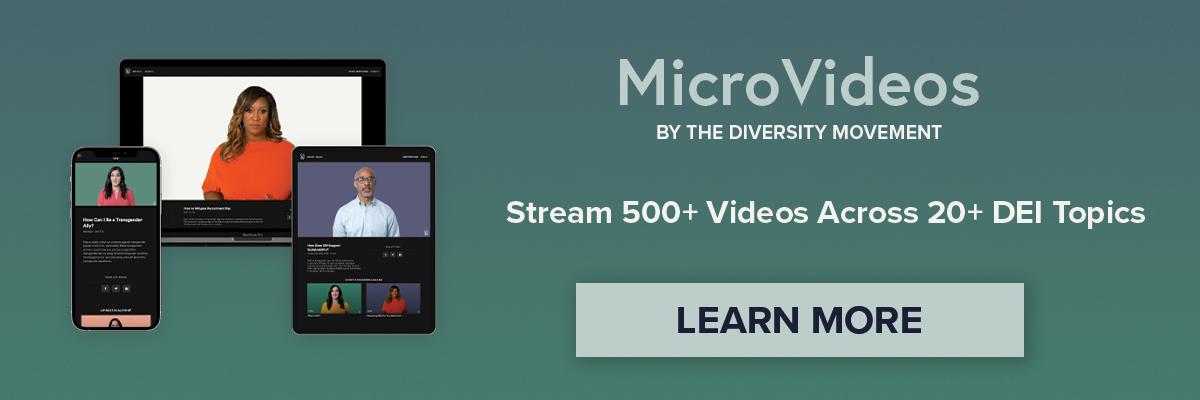The way that people express gender in the workplace is changing and has changed continuously since at least the 1960s, when society began to understand gender as a spectrum. Here, I put forth the idea that, although the gender spectrum model represents a step in the right direction, it doesn’t get gender identity or gender expression quite right. Gender is a sphere, not a line – a gradient color wheel, in fact.
There is no binary
Whereas the most widespread understanding of gender was once limited to just two identities – man or woman – with people expected to fit into those two binary categories, we now understand gender as a continuum. In this interpretation, some people identify closer to masculine, others closer to feminine, and many people move between the two or off of the spectrum entirely. The spectrum model implies that each person’s gender exists at a particular point along the continuum.
Yet gender expression is, and always has been, extremely fluid. It moves; it doesn’t rest. The way we present ourselves one day may be vastly different from how we present the next. For instance, I may wear a structured suit, pinned-back hair and minimal makeup one day, and a floral skirt, loose curls and bold red lip the next, or any combination of the two. Like most people, I choose to present as more masculine, feminine, or gender-free, depending on the day and circumstances.
You don’t need to find a single space on the gender spectrum and box yourself into it. The gender sphere allows room for movement and positioning firmly within both masculine and feminine points on the sphere.
You’re free to move around the sphere
In any book on history and civilization, you’ll find multiple examples of gender fluidity in practice. Despite what the backlash against Harry Styles’ Vogue cover may have led you to believe, men have always worn dresses and jewelry, and I hope they always will. That’s not to mention high heels, skirts, wigs and makeup.
More recently, you’ll find fluidity in gender expression by turning to people like Jonathan Van Ness, Alok Vmenon and Jake Dupree. These individuals present themselves as both masculine and feminine simultaneously, challenging traditional conceptions of a gender binary or a gender spectrum.
Masculine and feminine all at once
These examples of gender fluidity highlight the infinite range of natural human gender identities that have always existed in the gender sphere. We each have the right to determine what gender identity and gender expression mean to us personally – not just in our private lives but at work too.
Yet many people still face negative – and sometimes extreme – consequences for transgressing against gender norms. Those consequences may be as seemingly small as a side-eyed glance from a colleague or as severe as career stagnation, termination, ostracism, violence and verbal or psychological abuse.
Men are offered even less fluidity
Men in particular seem to be afforded less fluidity and acceptance for transgressing gender expectations. Two recent examples are the “Bring Back Manly Men” debacle of 2020 and the outright panic caused by Billy Porter wearing a dress on Sesame Street.
Another example is the way retailers frame ‘gender-neutral’ items, especially for children. Browse through any Target store, and you’re likely to see a dozen pink-and-purple Star Wars, Harry Potter, or Marvel superhero t-shirts, but no tulle, sequins, or “I Can Change the World” t-shirts in the ‘boy’ section. I anticipate the ‘boy’ and ‘girl’ clothing sections will become one gender-inclusive section in our lifetimes.
The resounding message is that female-bodied people can and should defy gender expectations, but male-bodied people should stay in the box. Meanwhile, the factual existence of nonbinary people is still up for debate in some circles, proving how far we have to go in embracing all genders on the gender sphere.
Get your workplace ready for the full gender sphere
The good news is that Gen Z is moving away from gender norms altogether and carrying us along with them. In fact, according to Harvard Business Review, a full 12% of Gen Z people identify as transgender or nonbinary; 56% say they know someone who uses gender-free pronouns; 59% believe that intake and application forms should include options other than man and woman, and “25% expect to change their gender identity at least once during their lifetime.”
Soon, understanding and accepting the full gender sphere – and the fluidity it affords – won’t be optional. It will be a foundational part of workplace inclusion, brand positioning, hiring and retention. We will have to embrace a gender sphere with the emergence of Gen Alpha. And if we aren’t ready, they’ll simply pass us by, working, shopping, and spending their time elsewhere. Here’s my advice for how to get ready.
- Conduct a policy check. Examine your employee manual and policies regarding dress code and hairstyles. Are they inclusive of all genders, or written in outdated, binary language? Consider restroom and healthcare policies, as well as your organization’s unwritten standards for appearance. Listening sessions and surveys are one way to find out what your unwritten policies really are.
- Put inclusive processes in place for name and pronoun changes. When an employee comes out as transgender at work and/or decides to change their name or pronouns, the last thing you want is for their courage to be met with resistance in the form of a complicated process. Work with HR to enact clear, inclusive processes.
- Support the success of transgender, gender-nonconforming, and genderfluid people. From shopping with LGBT-owned businesses to sponsoring someone in your network, there are always actions we can take to support people of all genders by engaging in active allyship.
Remember, just like the gender sphere, we as humans are not static. We’re constantly evolving our beliefs, values, and understanding of other people and ourselves. That means it’s never too late to rethink the way you view gender, and learn to embrace a fuller picture of what it means to express your natural identity.
Jackie Ferguson, CDE, hosts the Diversity: Beyond the Checkbox podcast. She is also a co-founder and Head of Content and Programming at The Diversity Movement. Connect with her on Linkedin.













